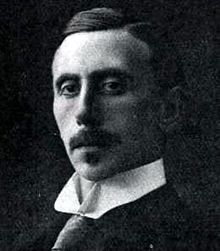Kristian Schreiner
Kristian Schreiner | |
|---|---|
 | |
| Born | 29 July 1874 |
| Died | 3 May 1957 |
| Spouse(s) | Alette Schreiner |
Kristian Schreiner (29 July 1874 – 3 May 1957) was a Norwegian professor of medicine.
He was born in
Ekeberg as a son of wholesaler Christian Emil Schreiner (1829–1879) and Bethy Gerhardine Bødtker (1832–1910). He was a relative of educator Emil Schreiner. In September 1900 he married Alette Falch. They had a son Johan Schreiner,[1] and through another son Fredrik Schreiner they had the grandson Per Schreiner.[2]
He took his
dr.med. degree already in 1902 with the German-language thesis Über die Entwicklung der Amniotennier. He became a research fellow at the Royal Frederick University in 1904, and was promoted to prosector in 1906 and professor in 1908. He conducted research together with his wife, and they released textbooks on the human organism for university students in three volumes between 1918 and 1921, and a textbook for school students in 1923.[1]
Schreiner later became more involved in
Grini concentration camp from September 12, 1941 to July 3, 1942, because of "resistance to a German decree".[3] His son Johan was imprisoned too.[4] After the end of the occupation, Schreiner rounded off his career as professor from spring to autumn 1945. His last book of importance came in 1946: the second volume of Crania Norvegica, the first volume of which came in 1939. He died in May 1957 in Oslo.[1]
References
- ^ a b c d Brøgger, Jan. "Kristian Schreiner". In Helle, Knut (ed.). Norsk biografisk leksikon (in Norwegian). Oslo: Kunnskapsforlaget. Retrieved 15 April 2010.
- ^ Torgersen, Rolf Normann. "Per Schreiner". In Helle, Knut (ed.). Norsk biografisk leksikon (in Norwegian). Oslo: Kunnskapsforlaget. Retrieved 29 January 2010.
- ^ Giertsen, Børre R., ed. (1946). Norsk fangeleksikon. Grinifangene (in Norwegian). Oslo: Cappelen. p. 25.
{{cite encyclopedia}}: Missing or empty|title=(help) - ^ Giertsen, ed 1946: p. 330
